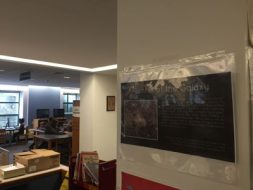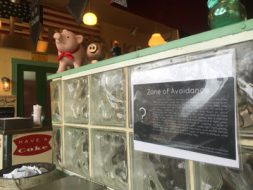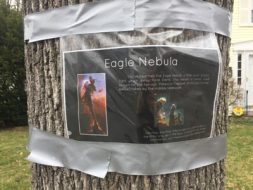I turned my town into a model of the Milky Way Galaxy for my high school astronomy project.

Nick Greenhalgh
If you had told me at the beginning of the year that my high school astronomy project would land me in the local paper, I wouldn’t have believed you.
This was partly because I didn’t even plan on taking astronomy. I’m a humanities kid through and through, lover of fantasy novels and other things decidedly unscientific. I planned on taking the least “mathy” class to fulfill my science requirement. But alas, there was a scheduling conflict, and so I opted for a half-year astronomy class.
Looking back, this was probably the best scheduling conflict of my life.
In a year of great courses, astronomy was one of my favorites. We explored the solar system, learned how stars live and die, and calculated the age of the universe. We speculated about exoplanets and extraterrestrial life. We got to have discussions about current events in astronomy, like when water was discovered on Mars. Sure, there was math, but it wasn’t impossible to understand.
For my final term project, I knew I wanted to do something none of my classmates had done. I ultimately decided I wanted to turn my town, Arlington, Massachusetts, into a scale model of the Milky Way Galaxy.
The Mass Ave Milky Way Project was named after a major street in our town — Massachusetts Avenue, or "Mass Ave" for short. The premise was relatively straightforward: if the Milky Way was the size of our town, where would various objects like star clusters and nebulae be? The idea was that as people walked and saw all the posters around town, they would learn different things in our galaxy, and gain a better understanding of the awe-inspiring scale of things in space. Everything would be unified on a website listing the location of each poster. As a bonus, if people sent in pictures of themselves at every location, I would send them a special prize.

Nick Greenhalgh
I am, of course, not the first to make a model to explain the vastness of space. My local Museum of Science has a solar system model, which starts at the museum and spans most of Boston. It seems that large-scale models of the solar system vastly outnumber those of the Milky Way. I think this is quite a shame, as Milky Way models aren’t that hard to construct.
If you want to do your own scale model of the Milky Way, all you need is a little middle-school math. I sketched the whole thing out on a map of my town. For the sake of simplicity, I decided to assume that everything was on a single plane — I love astronomy, but I’m not about to try to climb any telephone poles to demonstrate the relative thickness of the Milky Way. I picked a center point (the local library), got out a protractor, and drew a 2-mile-wide circle around it. Everything after that was basic scaling: 5 inches on the map is to 2 miles in town is to 100,000 light-years in space. The nearby branch library was conveniently located right where our solar system needed to be.
Filling out the galaxy then got a little complicated. I had three basic criteria for what went on the map: (1) could I explain it easily? (2) could I locate it? and (3) was there a picture? Constraints one and three meant that most of my objects were stars, star clusters, or nebulae. All of these are pretty easy to explain, and NASA has a wealth of images available. Plus, those kinds of objects are (scientifically speaking of course) really cool. Eta Carinae, for instance, is a binary star system with a luminous blue variable star, whose brightness changes over time. The red giant Betelgeuse is more than 900 times the size of our Sun. Even someone who’s never studied astronomy can look at something like that and appreciate just how amazing and alien outer space is.
Location, though, became a bit of an issue. For most objects, especially stars, it was easy to find the distance of the star from Earth. However, that doesn’t tell you much about what part of the galaxy it’s located in. I ended up approximating that based on a poster of the Milky Way by National Geographic, which featured the specific locations of various galactic features.
The hardest part for me was setting up the model. For each item on the map (I had nine) I typed up a small blurb about it and made a poster. Then, map in hand, I went around to the location of each star cluster/nebula/etc. and proceeded to essentially solicit nearby businesses. It was hard to come up with an elevator pitch; I ultimately landed somewhere between “help me introduce the masses to the wonders of our galaxy and bring them a new appreciation of the cosmos” and “help me get an A”. Explaining things could be complicated, as I learned while trying to describe the Zone of Avoidance to a harried cashier. But most places were actually really interested in the project — I guess it’s kind of cool to learn that, for instance, your bakery is right where one of the brightest stars in our sky is located. And when there wasn’t a friendly local business, I made do by duct-taping a poster of the Eagle Nebula to my best friend’s tree.

Nick Greenhalgh
Of course, I had other helpers. Instrumental to the project was my teacher, Mr. G, who among other things helped me find relevant and easy-to-understand information — and also let me do the project in the first place (which was really quite nice of him, considering the fact that I approached him with only a weird idea and no clue how to carry it out). And then there was Nick Greenhalgh, a local newspaper reporter, who asked me if he could publish an article on The Mass Ave Milky Way.
But of course!
The article was great, and even better was the fact that it alerted the wider public to the project. In the weeks after, five different people came forward to show that they had visited each site, ready to claim their prizes.
I will acknowledge that five is not a large number. Three were a couple and their infant son, one was an 8-year-old girl, and one was an 11-year-old girl who adored astronomy and was holding a stuffed Sun toy in all of her photos. If this project kept people like that interested in science and astronomy, then I think it was absolutely worth every minute I put into it.
The Mass Ave Milky Way Project is over now, since I’m moving away and then going off to college. The signs around town are gone, and website extends its thanks to all those who participated. But it continues to be one of the most enjoyable and inspiring things that I’ve done during my high school career. And the best part is, now that I know how to make a scale model of the Milky Way, I can do it again, wherever I go next.
Oh, and as for those prizes I mentioned? The ones I sent to people if they visited every poster? They were, of course, Milky Way bars.
Grace Hoglund is a recent graduate of Arlington High School who will be attending Seattle University in the fall. She currently plans to major in English, with eventual hopes of becoming a librarian.
 2
2








Comments
Anthony Barreiro
July 19, 2016 at 1:03 pm
How incredibly cool. Best wishes, Grace! When you're working as a librarian, I hope you'll find your way around Dewey Decimal Classification 500, especially 520.
You must be logged in to post a comment.
AB
July 22, 2016 at 8:10 pm
Great project. Good for you, making this effort to get others interested and involved with learning about science. I'm sure this kind of enthusiasm will serve you well in the future. Best of luck at college!
You must be logged in to post a comment.
You must be logged in to post a comment.